Organization In The Living Things Introduction
- There are millions of different things in this world around us. Some of them are living and some are not.
- People, cats, mice, insects, and trees, are living things, while rocks, water, chairs, and tables are not living and are called nonliving. Living things exist along with non-living objects on this earth.
- However, living things show certain characteristics that distinguish them from non-living things.
Read And Learn More: NEET Class7 Biology Notes
- These characteristics include cellular organization, nutrition, respiration, growth, excretion, reproduction, movement, and response to stimuli.
- In addition to cellular organization, living things exhibit a unique organization that allows them to coordinate the different functions of life.
Organization
- The term organization denotes the manner in which smaller units or components of any structure are aggregated into higher or bigger units.
- Each unit of aggregation represents the level. There can be different levels of organization.
- At each level, there are interactions between the units.
- The main functions of the organization are to help the living thing to perform different functions, and thus sustain life.
” living world neet notes”
2. Levels Of Organisation In The Living World
- There are two broad levels of organization – one below the level of the organism (the individual plant or animal) and the other above the level of the organism.
- These two levels constitute the lower levels and higher levels of organization respectively
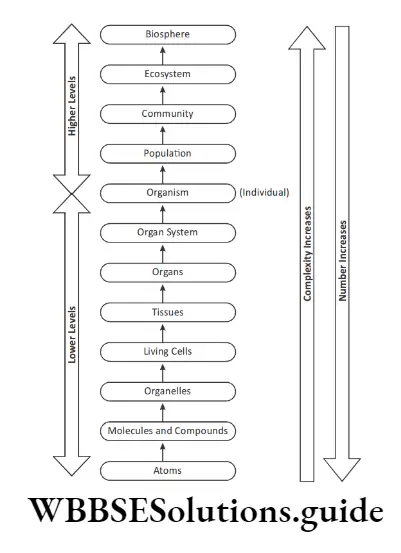
3. Lower Levels Of Organisation
Lower levels of the organization are of two types:
- Molecular level, and
- Cellular level.
Molecular Level
- All organisms are made up of cells.
- The cells are made up of smaller parts called organelles.
- The organelles in turn are made up of various molecules. The molecules are made up of atoms of various elements.
- Six of these elements (carbon, hydrogen, nitrogen, oxygen, sulfur, and phosphorus) make up 95% of living matter.
- Atoms of these elements are organized to form important molecules like those of water, carbon dioxide, methane, and so on.
- These molecules have further given rise to large molecules and compounds like carbohydrates, proteins, fats, and nucleic acids (DNA – deoxyribonucleic acid, RNA -ribonucleic acid).
- The living substance called protoplasm, which makes up cells, is made up of all these compounds.
- DNA is an important compound, responsible for the transfer of characters from parents to children. It is known as the molecule of life.
Thus, at the molecular level, the following organization occurs:
Cellular Level
1. Cells
- A cell is the lowest level of cellular organization.
- It is the smallest living unit and is capable of performing all the functions of life.
- In unicellular organisms like Amoeba, Paramecium, and bacteria, all the functions are carried out by a single cell.
- But it is not so in a multicellular organism. In a multicellular organism, although each cell can carry out the important functions of life, it is not capable of existence on its own.
- A muscle cell cannot obtain its own food or oxygen. Other specialized cells in the body collect food or carry oxygen.
- All the cells do not perform all the jobs. Different tasks or functions like ingestion of food, digestion, respiration, excretion, and reproduction are divided among groups of cells.
- For example, nerve cells are very long and this helps them to conduct messages from one part of the body to another.
- Similarly, in plants, xylem elements are long and tubular and are specialized for the movement of water from the roots to the stem and leaves.
- It would be clear from the above account that the body of a multicellular organism is highly organised.
- It shows various levels of organization, starting from the cells.
- Cells that are alike in size and shape team up. They work together to do special jobs. These cell “teams” are called tissues. Thus, cells combine to form tissues.
“neet the living world class 11 notes “
2. Tissues
- A group of similar cells that work together to do the same job is called a tissue.
- In other words, a tissue is a group of cells similar in structure and function.
- Tissues in plants – Epidermal tissue, vascular tissue, and ground tissue.
- Each of these tissues is meant for a different function. For example, the epidermis (epidermal tissue) which is the outermost layer of tissue provides protection to the plant body.
- The ground tissue represented by the cortex lies inner to the epidermis. It performs the function of storage. The vascular bundles (vascular tissue) help in the conduction of water and food materials.
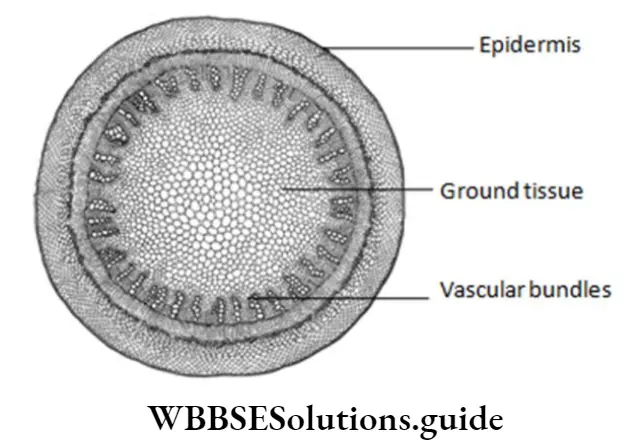
- All these tissues can be observed by taking a section of the root or stem.
- Tissues in animals — Epithelial tissue, connective tissue, nervous tissue, and muscular tissue.
- As in plants, different tissues in animals also perform different functions.
- For example, nervous tissue helps in the conduction of messages from one part of the body to another.
- Epithelial tissue is a protective tissue. Skin is an epithelial tissue.
- Connective tissue consisting of cartilage and bones provides support to the body.
3. Organs
An organ is a structure made up of different tissues working together to perform a specific function.
- Tissues combine to form organs.
- An organ is made of different kinds of tissues.
- Our stomach is an organ. It is made up of different tissues like nerve tissue, blood tissue, fat tissue, and muscle tissue.
- Similarly, the mouth, food pipe, and small intestine are all organs. These are organs of digestion.
- An organ performs a specific function.
Stomach as an organ
- The Stomach is an organ of digestion. It is made up of different tissues like epithelial tissue, nervous tissue, blood tissue, and muscular tissue.
- Different parts of the stomach help in the job of digestion of food. One part causes contractions and expansions so that the food is thoroughly mixed.
- Digestive juices are secreted by another part of the stomach. Different tissues take part in each of these activities.
“what is living class 11 biology notes “
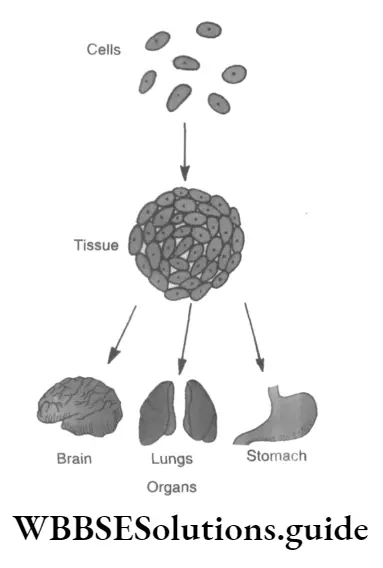
Similarly, your heart is an organ. The heart pumps blood. It is made mostly of muscle tissue, with some blood tissue and fat tissue.
These tissues work together to allow the heart to pump blood. “Your lungs and windpipe are organs used for breathing.
- Our kidneys are the organs of excretion.
- We also possess organs for sensing what is happening around us. The ear is a sense organ. The eyes, tongue, skin, and nose are sense organs too.
- The largest organ in the body is your skin. It covers and protects your body. It helps you to get rid of three waste materials — salts, water, and heat.
- Organs may be external or internal. The organs described above like the stomach, heart, kidneys, and intestine are internal organs. External organs, for example, include ears, eyes, arms, legs, hands and feet.
- In plants, roots, stems, leaves and flowers are organs. These organs perform different jobs and are composed of different tissues like the epidermal tissue, vascular tissue (xylem and phloem), and ground tissue.
4. Organ system
A group of organs working together is called an organ system.
- Our digestive system is an organ system. The organs of this system include the mouth, the food pipe, the stomach, and the intestines. Each organ has a special job to do.
- Together, they digest your food. Likewise, there are many systems in our human body.
- There are some organs that are parts of more than one system. For example: The liver is a part of the digestive system. The liver is also a part of the excretory system, which gets rid of wastes.
- The large intestine is a part of the digestive system. But it is also a part of the excretory system.
- In plants, there are two organ systems –– the root system and the shoot system. Each of these systems has several organs. For example, the shoot system has stems, branches, leaves, flowers, and fruits. The root system has roots and root branches.
“biology chapter 1 notes “
5. Organism
- The organ systems collectively form an organism.
- The whole organism is a product of all the systems working together in unison with each other.
- Each organism, thus, possesses a well-organised structure consisting of smaller parts.
- The cell is the smallest unit or level of cellular organization.
Molecular and cellular levels of organization are, thus, represented as follows
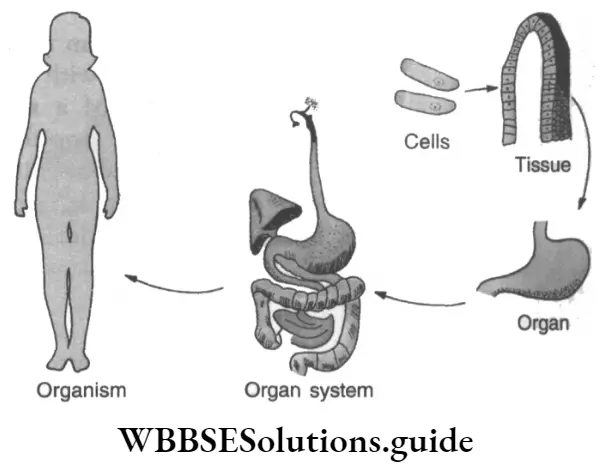
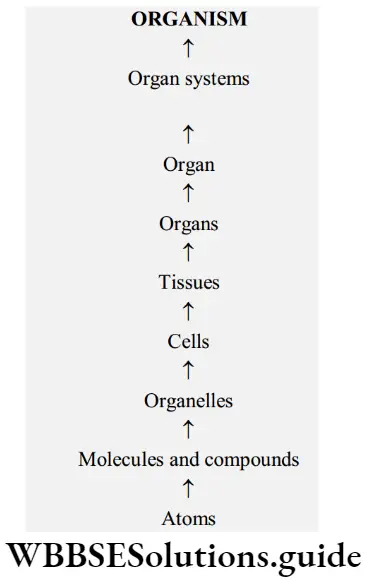
Higher Levels Of Organisation
Higher levels of organization beginning from the organism, in the order of increasing complexity, are the following:
- Population,
- Biotic community,
- Ecosystem, and
- Biosphere.
1. Population
- An organism or an individual does not exist in isolation. Rather, it lives in association with other individuals of its own kind, i.e., species.
- All the individuals of a single species existing in a given locality or area constitute a population.
- A population is, thus, the next higher level of organization above the individual level.
- For example, we belong to a human species called Homo sapiens. The different individuals occurring in a particular area represent a population of Homo sapiens.
- Likewise, there exist populations of different species of plants and animals.
- Individuals of populations of one species can breed among themselves only. They do not breed with individuals of other species.
- Thus, a frog breeds with a frog only and a cat with another cat. This is true
in the case of plants also. - The members of a population compete with each other for the same resources food, space, light, and water.
“the living world notes pdf “
2. Biotic Community
The populations of different species occurring in a locality constitute the next higher level of organization called the community or biotic community.
For example, in a wheat field, you find, along with wheat plants, other plants called weeds which grow in the wheat field. In addition, different kinds of insects, worms, birds, and mammals (like rats) are found in the field.
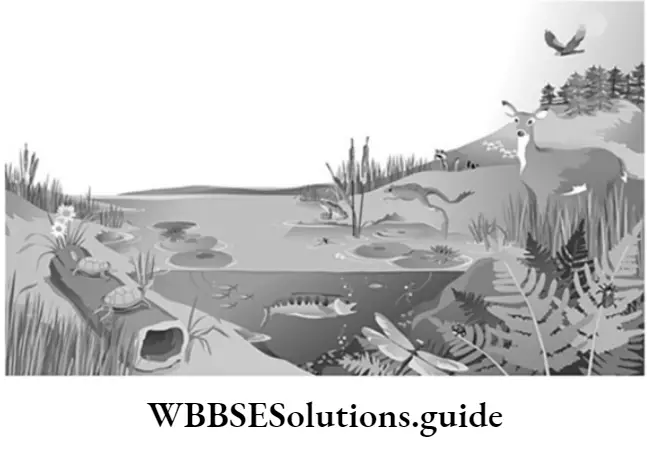
- The populations of all these different species found in the wheat field or any crop field constitute a biotic community.
- Members of different populations do not have similar requirements for food and shelter, though they live in the same area.
- Community, thus, is a higher level of organization above the population
3. Ecosystem
- The biotic community in an area interacts with the non-living physical environment, and the two (i.e., the biotic community and the abiotic environment) together constitute the next higher level of organization, termed the ecosystem.
- Forests, crop fields, deserts, ponds, and rivers are -all examples of ecosystems.
- There are two main components of an ecosystem — non-living (abiotic) and living (biotic) components.
- Abiotic components, or non-living components, include
- the physical environment (like soil, water, air, and minerals), and 2 climatic factors (light, temperature, wind, and rain).
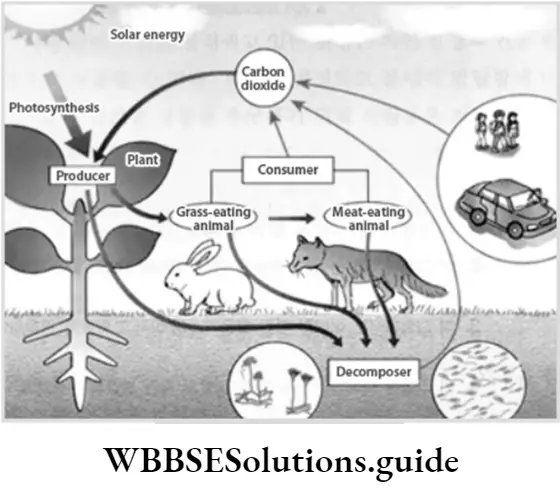
Biotic components, or living components, consist of
- Autotrophs or producers (green plants)
- Heterotrophs or consumers.
Different types of heterotrophs are herbivores and carnivores.
Decomposers (saprophytes) like bacteria and fungi play an important role in the recycling of minerals.
The different living organisms in an ecosystem are interconnected through the food chains starting from the producers to the consumers.
4. Biosphere
- The various ecosystems found in all the geographical regions of the world form the next level of organisation is called the biosphere.
- Biosphere is the highest level of organisation in the living world.
- The biosphere is that part of the universe that supports life in air, soil and water.
- Thus, all living organisms inhabiting soil, air and water constitute the biosphere.
The biosphere consists of four components, of which three are non-living. These are:
- Hydrosphere (water bodies)
- Lithosphere (land or soil)
- Atmosphere (air)
- Living organisms (plants and animals).
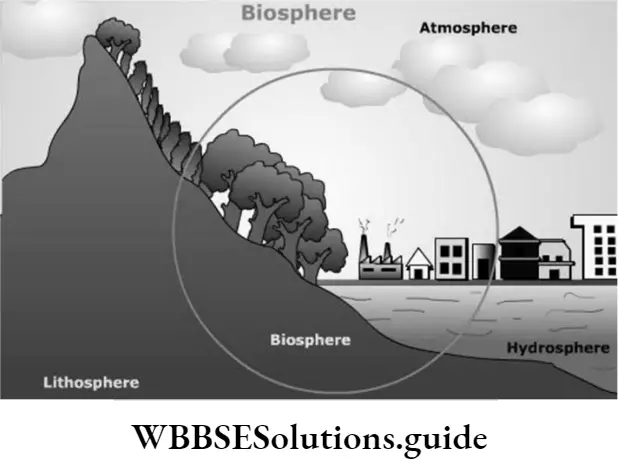
5. General Characteristics Shared By Levels Of Organisation
- All the levels in the living world, beginning from cells, consume energy to maintain themselves.
- Each level of organisation is more complex and has fewer units than the previous level.
- For example, there are lesser number of tissues than cells. Thus, the number goes on decreasing with increasing complexity, as one moves from a lower level to the next higher level.
- In other words, the number increases as we move down from the biosphere. The biosphere is only one, but there are many ecosystems functioning in the biosphere.
- Further, in each ecosystem, there are a number of communities, each of which consists of a large number of populations of different
species. - Each population, in turn, has a large number of individuals. This process of increase in number goes on, as we keep moving down from one level to another level of organisation.
- All constituent units of a particular level interact, cooperate and compete with each other, and ensure the success of that level.
Organ Systems In the Human Body
There are ten different organ systems present in our body. The different organ systems are as follows:
- Digestive system
- Respiratory system
- Circulatory system
- Nervous system
- Excretory system
- Reproductive system
- Skeletal system
- Muscular system
- Integumentary system
- Endocrine system
1. Digestive System
Parts of the Digestive System
- Mouth: Tongue, teeth, salivary glands
- Oesophagus (food pipe)
- Stomach
- Liver and gallbladder
- Small intestine
- Pancreas
- Large intestine
- Anus
“the living world notes pdf “
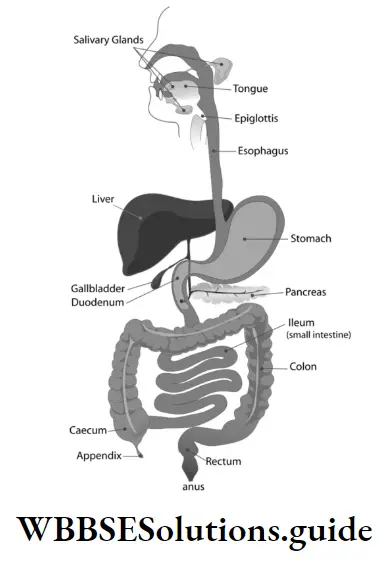
2. Respiratory System
Parts of the Respiratory System
- Nose
- Trachea (windpipe)
- Bronchi (singular bronchus)
- Lungs
Function: To exchange oxygen and carbon dioxide and produce energy.
Function: To convert complex food into a simple, soluble form so that it can be easily absorbed by the blood.
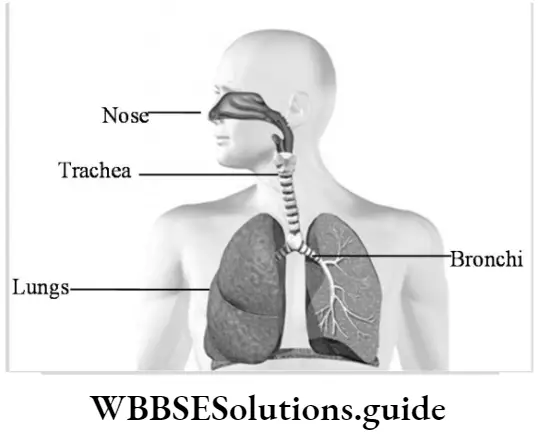
3. Circulatory System
Parts of the Circulatory System
- Heart
- Blood vessels (arteries, capillaries, veins)
- Blood (plasma, red and white blood cells, platelets)
Function: To transport gases and materials throughout the body.
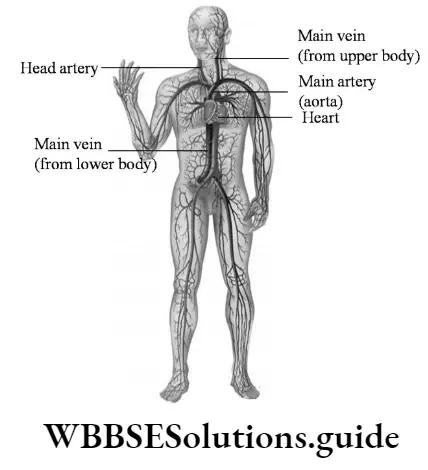
4. Nervous System
Parts of the Nervous System
- Brain
- Spinal cord
- Nerves (cranial nerves, spinal nerves)
- Sense organs (eye, ear, nose, tongue, skin)
Function: Controls the working of the body and coordinates body parts
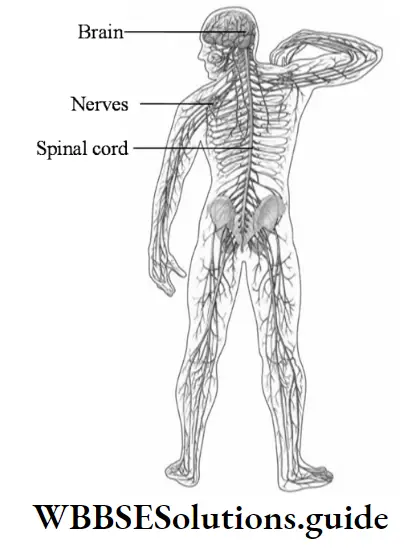
5. Excretory System
Organs of Excretion:
Lungs, kidneys and skin Organs of the Urinary system
- Kidneys
- Ureters
- Urinary bladder
- Urethra
Function: To remove waste products from the body.
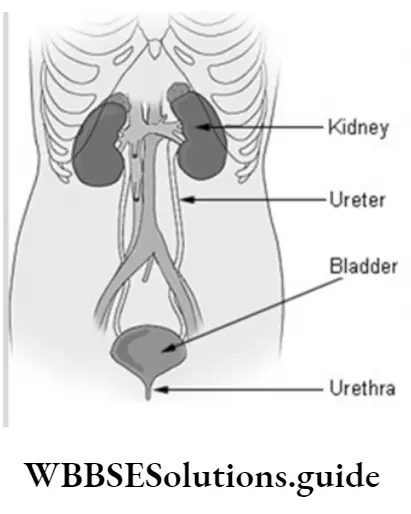
6. Reproductive System
- All living beings produce young ones of their own kind. This process of producing young ones of its own kind is called reproduction.
- It is an important characteristic of all living organisms and it is essential to ensure the continuity of life.
- “You may have seen birds laying eggs. How many animals can you think of that lay eggs? Birds, frogs, fish, turtles and insects all lay eggs.
- It takes two birds, a male and a female, to make the eggs. The female makes tiny eggs.
- The male makes special reproductive cells called sperms. The sperm fuses with the egg.
- The fused egg then gets bigger. Then, the female lays them and sits on them to keep the eggs warm. In two or three weeks, the young birds hatch.
- Mammals like cats, dogs, horses and humans also make eggs and sperm that fuse.
- In human beings, the male reproductive organs are called testes (singular testis) and the female reproductive organs are called ovaries (singular ovary).
- The males produce special tiny sex cells or reproductive cells called sperms. The females produce sex cells called eggs or ova (singular ovum). One sperm fuses with an egg and this process of fusion is called fertilisation.
- Reproductive System in Humans The fused eggs or zygotes stay inside the female’s body (in the uterus) until they have grown into baby animals (like pups in the case of dogs, kittens in the case of cats, and human babies in the case of human beings).
- When the babies are born, the mothers make milk specially to feed them. They look after them for quite a long time.
“the living world notes pdf “
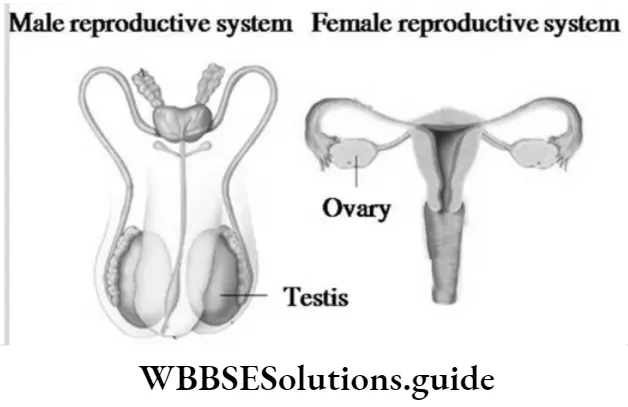
7. Skeletal System
- In our body, the different organ systems that you have studied so far consist of delicate organs like the stomach and heart.
- To support and protect these organs in their places and to keep the body upright, a rigid supporting system is required.
- Such a system is called a skeletal system. A skeletal system consists of bones and cartilage present in the body from head to toe. Bones are hard and are present in the skull, backbone or spine (as vertebral column consisting of vertebrae), chest (as ribs) and limbs.
- In all, there are about 208 bones in the human body. The cartilage is comparatively soft and elastic. The points or places where two bones are joined are a joint.
- There are 22 joints in our body. The joints help us to bend our body. Skeleton is the term used to describe the framework of the body formed by the bones and cartilage.
- Have you ever seen an X-ray unit in a hospital? Doctors use X-rays to examine the bones in our body, particularly when you suffer from a fracture.
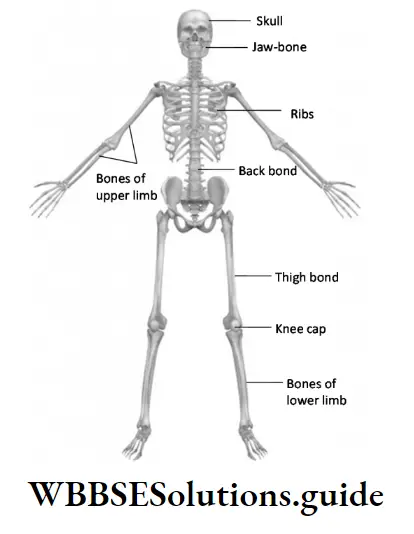
Parts of Skeletal System
Bones of the skull, ribs (chest), vertebral column (backbone or spine), and the limbs (hands and legs).
Functions of Skeletal System
- Protection: It protects delicate internal organs from injury.
- Provides form and shape to the body.
- Movement: Bones provide a surface to which muscles are attached. Contraction and relaxation of muscles produce movement.
- When we are born we have more than 300 bones in our bodies. By the time we have grown up, there are about 208. Many of the infant’s bones get joined together or fused.
- Giraffe has seven bones on its neck, just like us.
8. Muscular System
A muscular system consisting of muscles helps in locomotion and movement. Locomotion is the result of the coordinated action of muscles of the limb bones. The contraction and relaxation of muscles move the bones. Many bones of the skeleton act as levers.
When muscles pull on these levers, they produce movements, such as the breathing movements of the ribs, the chewing action of the jaws and the flexing of the arms.

